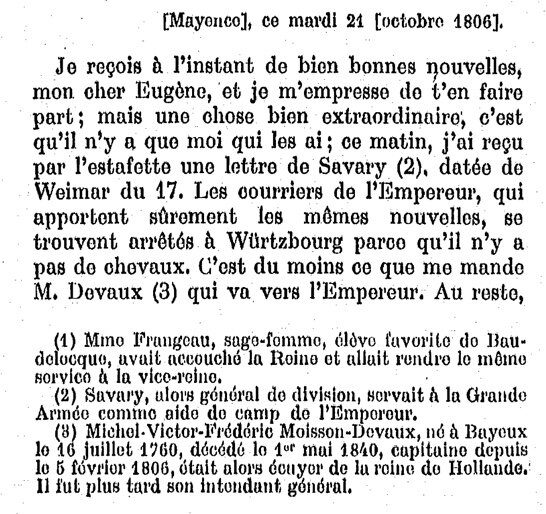This is part of a series of letters by Napoleon’s stepdaughter Hortense to her brother Eugene. Hortense writes about the famous occasion where the very beautiful Queen Louise of Prussia dressed up in a lady uniform and whipped the soldiers into a frenzy on horseback only to have to run off shortly.
Mayence, Tuesday 21st of October 1806.
I am receiving very good news at the moment, my dear Eugene and I hasten to share it with you but a very extraordinary thing is that it is only I who have it. This morning, I received from the messenger a letter from Savary (1), dated from Weimar on the 17th. The mail stopped there as there are no horses. At least, this is what M. Devaux (2) tells me.
He is the one who will go to the Emperor to tell him. Besides, Savary writes to me from Weimar Castle. He tells me Erfurt surrendered and delivered 17,000 prisoners, one hundred pieces of cannon, twenty-eight flags, including those of the Queen's regiment, embroidered by her own hand, Marshal Moellendorf, the Prince of Orange and ten other generals whose names are unknown have all been made prisoner; it is a second “Ulm”. Queen [Louise of Prussia] only had time to flee in a carriage.
She had the troops maneuver in front of the whole Weimar court: she was on horseback, wearing the uniform of her regiment, but now she only thinks of fleeing.
Goodbye, I kiss you.
HORTENSE.
(1) Savary, a general of division, went to the Grand Army as aide-de-camp to the Emperor.
(2) Michel-Victor-Frédéric Moisson-Devaux, born in Bayeux on July 16, 1760, he died on May 1, 1840. He was captain since February 5, 1806 and he was then the travel manager of the Queen of Holland. He was later her intendant general.
Cela fait partie d'une série de lettres de la belle-fille de Napoléon Hortense à son frère Eugène. Hortense écrit à propos de la célèbre occasion où la très belle reine Louise de Prusse s'est habillée dans un uniforme et a fouetté les soldats dans une frénésie à cheval pour avoir à s'enfuir sous peu.
Let’s look at the transits the day of this letter. Hortense’s adored oldest son, Napoleon Charles - the French heir - will soon die. Morbid Saturn (along with many other planets) is starting to transit dark and transformative Scorpio, starting in Hortense’s house of values (Venus). Hortense will lose what she most values and this will transform her into a different person.
Without this death, she probably would not have conceived Napoleon III. She wrote that she tolerated the advances of her husband in a state of deathly depression that lowered her resistance to him. The sad beginning of Napoleon III!
After her son’s death, Hortense will become very rebellious. A tendency we already see in her natal placement of Uranus near her midheaven. Hortense’s most famous son, Napoleon III, shared with her a prominent midheaven Uranus. Both were perennial centers of revolution. Hortense frequently laments this fact about her life in her writings and letters (midheaven in Mercury/Gemini, 7th house Mercury).
Regardons les transits le jour de cette lettre. Le fils aîné adoré de Hortense, Napoléon Charles - l'héritier français - va bientôt mourir. Morbid Saturne commence à transiter par le Scorpion sombre et transformateur, à partir de la maison de valeurs d'Hortense (Vénus). Hortense perdra ce qu'elle apprécie le plus et cela la transformera en une personne différente. Sans cette mort, elle n'aurait probablement pas conçu Napoléon III. Elle a écrit qu'elle tolérait les intérêts de son mari dans un état de dépression mortelle qui a réduit sa résistance à lui. Le triste début de Napoléon III!
Après la mort de son fils, Hortense va devenir très rebelle.
Une tendance que nous voyons déjà dans son placement natal d'Uranus près de son milieu du ciel. Le fils le plus célèbre de Hortense, Napoléon III, a partagé avec elle un éminent Uranus du milieu du ciel. Les deux étaient des centres perpétuels de révolution. Hortense déplore souvent ce fait de sa vie dans ses écrits et ses lettres (Milieu du Ciel dans Mercure / Gémeaux, 7e maison Mercure).
Napoleon III’s Uranus conjunct midheaven can be seen below.
On peut voir ci-dessous le milieu du ciel conjoint d'Uranus de Napoléon III.








